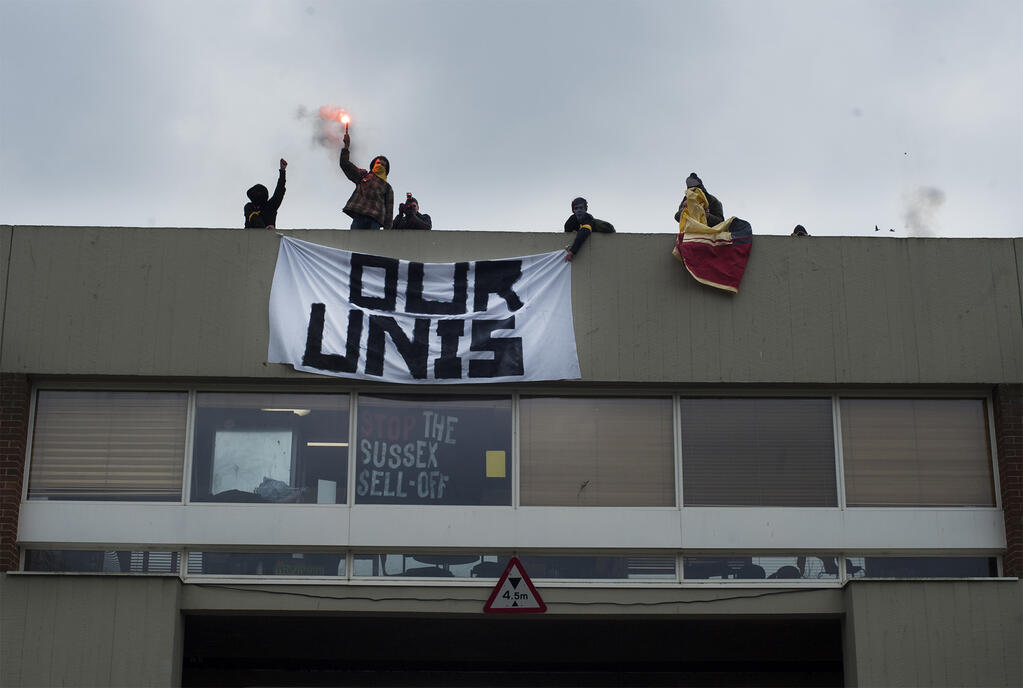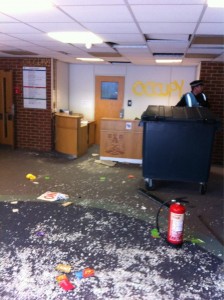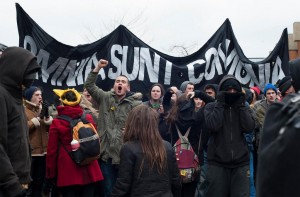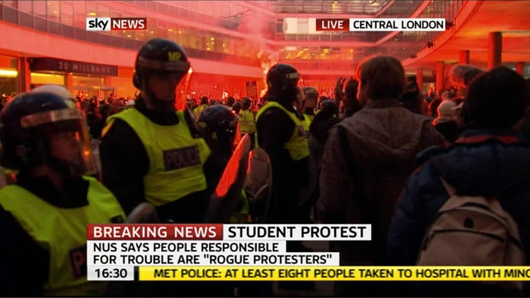The occupation at the University of Sussex began on 7 February over the university management’s intention to outsource 235 jobs to private companies. Since then a “Sussex Against Privatisation” blog has received heavy traffic and yellow squares – the adopted symbol of the campaign – have become ubiquitous across the campus, adorned everywhere from coats to windows. After over six weeks of occupation in the conference centre of Bramber House, the campaign was escalated with a national call-out for a demonstration to be held on 25 March.
The day began promisingly, and it was clear the occupiers had been planning their actions meticulously in advance. Five campus cafes, all of which are being threatened with outsourcing, were occupied resulting in the closure not only of those workplaces but also of other food venues across campus. The response from the staff at the cafes was overwhelmingly positive, which is a testament to the success of the campaign in engaging and involving those who are directly affected by the privatisation plans. One café worker told occupiers, “Thanks everyone, we get a day off!”
“We need revenge for the way students, protestors and the anti-austerity movement were brutalised by the police.” Alfie Meadows
From the 2000-strong opening rally at 1pm in Library Square, it was clear that much has been learned since the birth of the student movement in 2010. Banner drops were carried out in pre-planned locations. People employed rope ladders to pass banners to the roof. A Labour MP was booed. It seems that in two and a half years, people have honed an idea of what a protest should look like, and what it should not: ‘communism’ banners, yes; Labour MPs at rallies, no. The final speaker was Alfie Meadows, the student who required life-saving brain surgery following a blow from a police baton in 2010 and has just been acquitted from a two-year long court proceeding. Greeted by huge cheers, Meadows said, “We need revenge for the way students, protestors and the anti-austerity movement were brutalised by the police.” This inarguably set the tone for the demonstration. The rally was followed by a short march to Sussex House, the university’s management and administrative hub. Fronted by a book bloc, the crowd voiced its anger towards Vice-Chancellor Michael Farthing – many wearing a mask of his face – before forcing the glass doors through. “We want his office, that’s what we’re after,” said Amy, a participant in the anti-privatisation campaign. “It’s tucked away down a corridor where he never has to face us.”
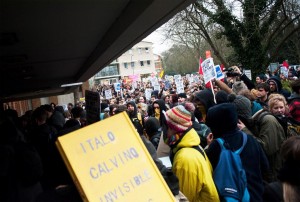
After the initial breach of the doors and seizure of the building, two things happened. Firstly, a line of riot police in caps tried to get to the building, pushing and striking protestors as they went. This was met with fierce opposition and chants of “no justice, no peace: fuck the police!” Unable to reach the building’s entrance, the police tried to turn back before they were pushed into their own little ‘kettle’ in a corner by the doors. Suffice to say the mirth of the protestors – many of whom I suspect are now veteran witnesses to police brutality on demonstrations – was uncontainable, with many shouting the familiar football chant, “who are ya?!”. Secondly, a large group made their way upstairs and attempted to hold a good old-fashioned jazz hands meeting. If a consensus to hold the building was met, it was by no means conclusive among demonstrators outside. While some made efforts to secure the building, somewhat ironically attempting to block the large gap where glass doors had stood just 40 minutes prior, others advocated causing as much damage as possible before moving on to another building in order to maximise the economic impact of the demonstration. Despite a degree of ensuing confusion, the preparations of the occupiers proved useful once again. Following the police retreat, demonstrators linked arms to form a human barricade across the street many rows deep which prompted a standoff for about 25 minutes. Unfortunately, around 25 police were then able to enter the building by a rear exit, making re-securing the building virtually impossible without risking physical danger. However, it is noteworthy that the police avoided direct confrontation with the protestors for the remainder of the day.
Afterwards, beneath yellow fireworks let off from the roof of a university building, the group – now about 500-strong – made its way to the existing occupation at Bramber House, where the excessive numbers were able to expand the parameters of the reclaimed space in securing the entire top floor. Some smoked on the balcony, some tried to hold a meeting; others lamented the brevity of the occupation at Sussex House. Liberating some cake in the conference centre kitchen, I overheard one student say, “If we had got Sussex House, the university would not have been able to run!”
“Yeah,” said his friend. “But we would probably have been, like, trapped.”
He replied, “Yeah, but trapped is kinda what we want…”
“It’s like a 2010 reunion!”
I was a visitor to the demonstration, so my observations on the composition of subjectivities present can only come from my limited time on the Sussex campus, and though some trends could be extrapolated to the wider movement, I wouldn’t like to claim my thoughts on the Sussex demonstration are in any way authoritative. In writing three of them here, my hope is that readers can consider how this contemporary moment of excess relates to the student movement’s condition in the present and possibilities for the future.
The first thing which struck me was the confidence demonstrated by those present. Judging by the intuition displayed in their distrust of the police and instructions for holding meetings, it would be fair to say most of the group were either seasoned student activists or had been influenced by their experiences of student-led occupations or the Occupy movement. However, the presence of ‘black bloc’ types was minimal and though Socialist Workers Party and Socialist Party paper vendors were out in force, they were generally side-lined. Rather, the impression I got was that most of those pushing down the doors or kettling the police could be summed up as angry and unaligned. This brings me to a second observation. As perhaps encapsulated by the vehement smashing of the doors before the frantic blocking of the threshold, or the conversation with our friend in the conference centre kitchen, a lot of the aims and ideas present were very clearly conflicting. This is not to be dismissive: the campaign at Sussex has shown an impressive tendency for creativity and experimentation, which has clearly come about through embracing difference and diversity. However, I can’t help wondering if for every Sussex student who is relatively new to the world of student activism, there was present a self-styled ‘professional activist’, created by the events since autumn 2010. While both were without doubt attending out of a genuine sense of outrage at the creeping privatisation across the university sector, I wonder if the latter’s motivations are not coupled with a desire to recapture the ‘Millbank moment’ and a ressentiment both towards the atrocities committed by government and police, and the abject limbo within which their newly-formed subjectivity seems to exist. As I mingled among too many familiar faces in the occupied Bramber House, someone summed up the feeling with a glib remark, excitedly commenting: “It’s like a 2010 reunion!”
the propaganda and activity surrounding the anti-privatisation campaign at Sussex has had a distinctly independent character
There was a notable absence from the demonstration, which prompts my third observation. Scattered across the #Mar25 hashtag, we were encouraged with forced enthusiasm to write to our MPs, asking them to support the Early Day Motion being introduced to Parliament by the Green MP, Caroline Lucas. On the ground at Sussex, this tokenistic and shoddy attempt by the National Union of Students (NUS) to meet and reflect the desires and anger of its members was met with indifference and even laughter. Far from the historical attempts of the at-times Trotskyist-dominated National Campaign Against Fees and Cuts to lobby the NUS into holding another national demonstration, the propaganda and activity surrounding the anti-privatisation campaign at Sussex has had a distinctly independent character, often even hinting at ideas of autonomism or communisation. Above all, it has been characterised by an unwillingness to be mediated. This is an interesting and, I would argue, welcome turn within the embers of the movement, which could well be the key to its reignition. Recent propaganda generated by the Imaginary Party points to the rejection of institutions such as the NUS due to its restraining effect upon activity, and the Sussex campaign has had an especially grassroots character. Incidentally, the Sussex students’ union has been less than vocal in supporting its students and their staff, opting instead for a technical intermediary role as has become so familiar with SUs countrywide. Increasingly, students originally galvanised and radicalised in 2010 are finding their own feet and carving out their own, new, political identity. Having had two years to flirt with and become disillusioned by bureaucratic institutions and competing leftist factions, the Sussex occupation may mark the beginning of something exciting which will capture and better reflect the subjectivities created post-Millbank. In this light, perhaps one of the most interesting and promising developments to come from #Mar25 was the announcement of the ‘Pop-Up Union’, which is seeking to bring together workers from across the university whatever their relevant mainstream ‘trade’ union may be, in order to coordinate industrial action in a democratic, inclusive and horizontal way.
At the end of the day as the cold began to get to everyone and people made that all-important decision between sitting in a circle for a meeting or taking some cigarettes to the balcony, I heard someone speak through a megaphone from the bottom of Bramber House, clearly desperate for more action. “This is shit. Who’s got any ideas?” I expect the answer is along the lines of ‘more than we realise’. Certainly, it is promising that people are increasingly becoming confident in running with their own ideas rather than deferring to perceived ‘higher authorities’. I had to leave at around 4pm, but after I left I heard the occupation had been extended yet again, now securing the entire building – a huge four storey conference centre, marking what has to be the largest occupation in recent British history. A national meeting involving around 600 people took place, and although slightly chaotic a general consensus appeared to emerge to hold rolling national demonstrations on university campuses across the country. Watch this space.
This article was written by a member of Thames Valley Plan C

